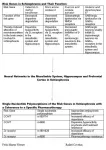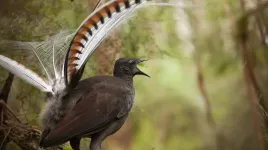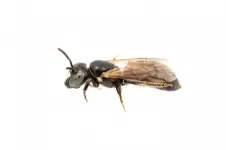Just published: Compilation of research on PFAS in the environment
2021-02-25
(Press-News.org) Per- and polyfluoroalkyl substances (PFAS) are a class of man-made chemical compounds and a current, emerging concern to environmental health. PFAS substances have unique characteristics-resistance to heat, water, oil and stains-that make them useful in a variety of industrial applications and popular in consumer goods. Many PFAS are stable and long-lasting in the environment, acquiring the name "forever chemicals." Industrial use of some of these compounds has been halted; however, many derivatives are still in commerce and more are under development. PFAS are now found in many compartments of the environment.
In order to manage PFAs in the environment, a lot of research has been directed at understanding their sources, fate and transport in the environment, and their potential effects on humans and wildlife. Recently, Environmental Toxicology and Chemistry (ET&C) published a special issue dedicated to PFAS with 32 articles, providing a valuable summarization of risk assessment approaches for PFAS, which are needed for environmental managers and regulatory bodies to set appropriate drinking water standards and health advisory guidelines.
The published research illustrates that PFAS are ubiquitous and raise more questions than answers about their potential toxicity to humans and wildlife. The articles in the issue report that PFAS were found near defense bases, urban environments, treatment plants and waste disposal sites but also in remote, less inhabited areas. PFAS were detected in breeding kittiwakes in Svalbard, Norway, and ducks in Australian estuaries. They were found in hens' eggs, soil, tadpoles, zebrafish, house crickets; the list goes on. The breadth of the published research illustrates that PFAS have dispersed in every medium in the environment (soil, water and wildlife).
In some of the studies, the presence of PFAS was related to a nearby source while in others it was not determined. For example, the authors of the article that investigated PFAS in Australian ducks did find a correlation between local sources of PFAS and bioaccumulation in ducks and noted that "Human health risk assessment showed that only ducks inhabiting wetlands near local sources of PFAS were likely to pose a risk to consumers," and continued, "Management of food consumption from these locations is an effective measure to limit exposure." In another study published in this same issue, long-chain PFAS were found in eight fish species across ten European glacial lakes in the Alps region, and while correlated to urban areas, could not be attributed to a specific, nearby industry source.
The issue illustrates that there are a tremendous number of PFAS substances, and it is a challenge for environmental managers and regulatory bodies to devise an approach to identify, understand and manage them all. The series provided a great review of the state of the science of PFAs risk assessment and also identified data gaps and the work needed to fill them in order to devise an effective approach to manage PFAS.
INFORMATION:
ELSE PRESS RELEASES FROM THIS DATE:
2021-02-25
On January 14, 2021, the Department of Health and Human Services (HHS) submitted notice to the Federal Register that it would issue practice guidelines that exempt physicians from the requirement to apply for a waiver to prescribe buprenorphine to treat opioid use disorder (OUD) in up to 30 patients at one time. This exemption has been placed on hold by the Biden administration and may require legislative change to implement. An exemption to the X-waiver has the potential to help reverse the morbidity and mortality associated with the opioid overdose epidemic, although without accompanying changes and attention it will not be enough.
The combination of the COVID-19 pandemic and the opioid overdose epidemic fueled by high-potency synthetic ...
2021-02-25
Dr. Felix-Martin Werner, working at the Euro Academy Pößneck in Germany and Prof. Rafael Coveñas, working at the Institute of Neurosciences of Castilla and León, Salamanca in Spain, have been working on neurological and psychiatric disease for over ten years. In their most recent review, published in Current Pharmaceutical Design (Bentham Science Publishers) Werner and Coveñas cover information about the risk genes in schizophrenia and explain the importance of examining their single nucleotide polymorphisms (SNP's). In schizophrenia, 260 risk genes ...
2021-02-25
A computer network closely modelled on part of the human brain is enabling new insights into the way our brains process moving images - and explains some perplexing optical illusions.
By using decades' worth of data from human motion perception studies, researchers have trained an artificial neural network to estimate the speed and direction of image sequences.
The new system, called MotionNet, is designed to closely match the motion-processing structures inside a human brain. This has allowed the researchers to explore features of human visual processing that cannot be directly measured in the brain.
Their study, published in the Journal of Vision, uses the artificial system ...
2021-02-25
Over many decades now, traditional drug discovery methods have steadily improved at keeping diseases at bay and cancer in remission. And for the most part, it's worked well.
But it hasn't worked perfectly.
A lab on UNLV's campus has been a hub of activity in recent years, playing a significant role in a new realm of drug discovery -- one that could potentially provide a solution for patients who have run out of options.
"It's starting to get to the point where we've kind of taken traditional drug discovery as far as we can, and we really need something new," said UNLV biochemist Gary Kleiger.
Traditional drug discovery involves what is called the small molecule approach. To attack a protein that's causing disease in a cancer cell, for instance, ...
2021-02-25
With COVID-19 making it vital for people to keep their distance from one another, the city of Toronto undertook the largest one-year expansion of its cycling network in 2020, adding about 25 kilometres of temporary bikeways.
Yet, the benefits of helping people get around on two wheels go far beyond facilitating physical distancing, according to a recent study by three University of Toronto researchers that was published in the journal Transport Findings.
University of Toronto Engineering PhD candidate Bo Lin, as well as professors Shoshanna Saxe and Timothy Chan used ...
2021-02-25
Ithaca, NY--Famous for their uncanny ability to imitate other birds and even mechanical devices, researchers find that Australia's Superb Lyrebird also uses that skill in a totally unexpected way. Lyrebirds imitate the panicked alarm calls of a mixed-species flock of birds while males are courting and even while mating with a female. These findings are published in the journal Current Biology.
"The male Superb Lyrebird creates a remarkable acoustic illusion," says Anastasia Dalziell, currently a Cornell Lab of Ornithology Associate and recent Cornell Lab Rose Postdoctoral Fellow, now at the ...
2021-02-25
URBANA, Ill. - Food waste is a major problem in the U.S., and young adults are among the worst culprits. Many of them attend college or university and live on campus, making dining halls a prime target for waste reduction efforts. And a simple intervention can make a big difference, a University of Illinois study shows.
Shifting from round to oval plates with a smaller surface area can significantly reduce food waste in dining halls, says Brenna Ellison, associate professor in the Department of Agricultural and Consumer Economics (ACE) and co-author on the study.
"Americans waste about 31% of the food that is available at the retail and consumer levels," Ellison says. "All-you-can-eat ...
2021-02-25
West Virginia University scientists used MRI scans to show what happens when ultrasound waves target a specific area of Alzheimer's patient's brains. They concluded that this treatment may induce an immunological healing response, a potential breakthrough for a disease that accounts for up to 80% of all dementia cases.
Rashi Mehta, a researcher with the WVU School of Medicine and Rockefeller Neuroscience Institute, led the study that appears in the journal Radiology.
"Focused ultrasound is an innovative technique and new way of approaching brain diseases, including Alzheimer's disease," said Mehta, an associate professor ...
2021-02-25
New research in mice published today in the journal Scientific Reports strengthens the growing scientific consensus regarding the role of the gut microbiome in neurodegenerative disorders including Alzheimer's disease.
The study, led by researchers at Oregon Health & Science University, found a correlation between the composition of the gut microbiome and the behavioral and cognitive performance of mice carrying genes associated with Alzheimer's. The mice carried the human amyloid precursor protein gene with dominant Alzheimer's mutations generated by scientists in Japan.
The study further suggests a relationship between microbes in the digestive tract ...
2021-02-25
A widespread field search for a rare Australian native bee not recorded for almost a century has found it's been there all along - but is probably under increasing pressure to survive.
Only six individual were ever found, with the last published record of this Australian endemic bee species, Pharohylaeus lactiferus (Colletidae: Hylaeinae), from 1923 in Queensland.
"This is concerning because it is the only Australian species in the Pharohylaeus genus and nothing was known of its biology," Flinders University researcher James Dorey says in a new scientific paper in the journal Journal of Hymenoptera Research.
The ...
LAST 30 PRESS RELEASES:
[Press-News.org] Just published: Compilation of research on PFAS in the environment






